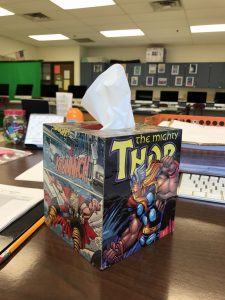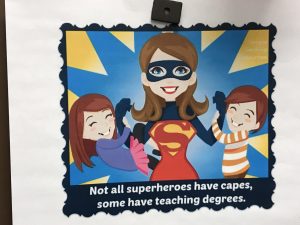
Many of us are entirely occupied trying to get through this school year. Some of us are being evaluated on this performance, even as we juggle the online learning of our students and our own children, while sharing technology with family members who are working at home. In these circumstances, a be-here-now approach to daily life is entirely understandable. Who wants to think about impending meat shortages? Or teaching toilet paper rationing to kids only a few years out of diapers? Hugs to my many readers who are juggling a growing set of flaming swords.
But we educators should start thinking seriously about next year. When possible, teachers should be communicating with their districts and even school board members. Your school board may at this very moment be making decisions that will define the quality of your life next year.
Will your school shift to staggered start times in order to cut class sizes? Another model breaks the school into different grades on different days — first, third and fifth grades attend Monday, Wednesday and Thursday for example. Will students and teachers be expected to wear face coverings? How will the district set up busses? Depending on virus levels in the area, mass transit can pose a major infection risk to students and drivers. How will lunch be managed? What about recess? More lunch periods equals fewer students per table. Will those half-hour lunches begin at 10:00 A.M. and end at 2:30 P.M.? In many crowded schools, lunches already begin before 11:00 A.M.. I would expect school assemblies and sporting events to be cancelled in areas where COVID-19 is prevalent.
The virus won’t be contained by fall. Any pipe dreams that include the mysterious disappearance or even control of the coronavirus should be understood for the fantasies that they are. We will have better control of COVID-19 soon, enough to reopen schools in many areas. The curve has been flattening. Medical treatment has been improving. As states add more and better testing, hopefully combined with robust contact tracing, schools and even preschools should reopen.
This fact raises a set of questions for school boards, administrations and classroom teachers. What will this look like in the classroom? Will schools continue the social/physical distancing that now dominates public interactions? How will educators control for this? Staggered start times can help decrease crowding, but may also steal break and planning time. Whether class size goes up or down, how will teachers convince little kids to stay apart? I talked to a Principal today who observed that kindergartners naturally want to touch everything and everybody when they first get to school. Many are natural huggers, and we can’t put them all in individual, giant hamster balls. I guarantee they won’t stay in masks. The littlest ones will fail distancing regularly. And adolescents? Yes, teenagers can understand the concepts involved in keeping their distance, but they have a bad habit of viewing themselves as immortal. Will close contact be a disciplinary infraction?
Class sizes may be going up too, not down. Teacher shortages are already problematic in some areas. “Early” retirements appear inevitable. Some of those men and women with 28 years into the system will decide 28 years is enough, depending on their pension structures.
And what if a new coronavirus wave starts and school campuses are shut down again? This could be the year of ongoing blizzards, repeated microbial “snow” weeks. Schools will need back-up plans for their back-up plans potentially. Online learning will not become a memory soon. Outbreaks in a school are guaranteed to ensure shut-downs, whether short or long.
Here’s the big question: What does this mean for you?
School boards across the country are debating plans. Administrators are beginning to decide between options for scheduling. Depending on contracts, school days may automatically lengthen in response to these plans. Some plans involve taking temperatures and answering screening questions before staff and students are allowed in the door.
Issues of equity loom. How will districts help students who have fallen behind because of lack of access to online learning? How will districts prepare for possible future online learning? Summer school and tutoring are traditional methods to address students who missed material, but how will that school and tutoring be structured?
So many questions, and as yet so few definitive answers.
Eduhonesty: Teacher readers, it’s time to up periscope! What are your district leaders doing? I recommend you communicate with fellow teachers and communicate with your school board. Communicate with friends who have the ear of local district decision makers. Ask administration about plans that are evolving. Parents, please communicate too! Do you have helpful ideas? Hopefully better ideas than giant plexiglass hamster balls to put around your kindergarteners?
When creating a new system, it’s always best to get as much right at the start as possible. Getting this next year right will include understanding the authentic behavior of students, a factor that disappeared from the planning process of education brainstorms like NCLB and the Common Core. How do kids act? How will they react to proposed changes? Online learning suffered heavily from a lack of buy-in in the recent past. If we continue online, how can we improve student participation? A podcast does no good when no one watches it.
How will we organize lines? Library visits? Even the act of walking in the front door poses challenges. Teachers can help with these questions. Teachers might want to post these questions to a few people. They might want to suggest laying in a large supply of colorful duct tape to place in strategic spots across the floors of classrooms and other public spaces. Those purchase orders take time sometimes, and kids who have no idea what six feet might be can easily recognize a bright orange piece of tape.
Many of my readers are frantically busy right now. If this plea to communicate sounds overwhelming, please feel free to ignore me. Go make yourself a latte or another presentation for your online classroom instead. Or bake a delicious banana bread with rum topping. Do anything fun that will help you stay centered.
But I did want to put the idea of communication out there because many decisions are being made right now. Hiring for the year is happening right now. Decisions on reopening are likely right around the corner in some areas, Depending on your situation, you may want to make your voice heard.

Eduhonesty: We’re not going back to “normal” in the near future. We don’t know where we are going. If we must boldly go where no one has gone before, I suggest we try to pack as few surprises as possible into that trip.
P.S. I feel compelled to close with a caveat: If you are currently operating at full capacity, well, even Captain America took a few decades off to marry his beloved Peggy Carter. Steve Rogers made time for his dance. Please, reader, set aside your own dance time. Superheroes and teachers are entitled to relax with their kids or wheaten terrier sometimes, instead of saving the world.
P.P.S, With all the crazy, you may not want to even think about employment applications, but this could be the ideal time to search for that better paying position closer to home.
